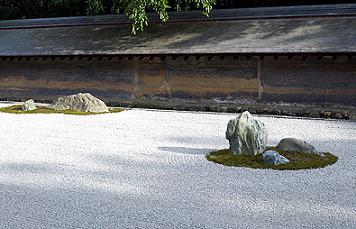ZEN FOR SALE
Temple priests have an economic incentive in selling the garden as an authentic, historic, and spiritual experience. Ryōanji, the Zen Buddhist temple and UNESCO World Heritage Site in Kyoto, Japan, is known around the world today for its famous stone garden. The garden of 15 small and large rocks resting on white gravel is seen as an expression of Zen art and considered a symbol of Zen Buddhism and Japanese culture. Reflecting on his 25 years of research on Ryōanji, art historian Kendall Brown explained how the history of this cultural icon presents challenges to these modern interpretations of its significance.

Photo : Joi Ito via Flickr
At a Jan. 14, 2008, lecture, at UCLA sponsored by the
Paul I. and Hisako Terasaki Center for Japanese Studies, Brown said he hoped to “put a few cracks in the iconic façade of Ryōanji.” Brown is a professor of art history at California State University, Long Beach, and a curator at the Pacific Asia Museum in Pasadena, Calif.
Tradition holds that Hosokawa Katsumoto, a military leader of the Muromachi period (1336-1573), founded the temple in 1450. He was killed during the Onin War (1467-77), and the original temple buildings burned down. The site became the Ryōanji temple upon reconstruction in 1488-1499, according to the account.
There is debate over who designed the rock garden at the temple, but many attribute the design to Japanese painter and landscape gardener Soami (1480–1525).
Brown expressed skepticism about the received history of the garden. He said that it could have been created long after 1488 and modified as late as 1798.
“We do not know exactly when the garden was made—for whom, by whom, or for what purposes,” Brown said. “Likewise, its appearance prior to 1681 is unrecorded; in 1681, we have our first visual documentation of it.”
Brown argued that it remains unclear what the original garden looked like. Some sources say there were originally nine stones in the garden instead of the 15 that lie there today. Some say there was a cherry tree in the garden. Others even say a bridge bisected the garden.
He said that the conventional history of the temple and garden is in direct conflict with its mysterious past and is a result of increased tourist interest.
Nationalizing and Commercializing Zen
Brown also contested the prevailing notion that the rock garden is a symbol of Zen Buddhist philosophy and Japanese culture.
“This eruption of interpretation is largely the product of the 20th century,” Brown said. “The garden enjoyed an only modest reputation from the 16th to the early 19th century.”
He said the garden achieved its status as a symbol of Japanese culture during the 1930s amid growing nationalism. It was seen as “an exemplar of Japanese intellectual, spiritual, and aesthetic continuity.”
He also said there was no direct reference to it as a Zen garden until 1935, when the essay “A Sermon in Stone” was published in The Art of Japanese Gardens. The notion that the garden distilled Zen thought spread during the postwar period.
“The inherent power of stones—together with their mysterious arrangement is a fundamental statement of Zen—has become the orthodox and indeed the authorized interpretation,” included in the official tourist pamphlet, according to Brown. The idea is reinforced by books like Reading Zen in the Rocks, which was published in 2000.
After Queen Elizabeth II visited the garden in the 1960s, Brown said, it began to attract greater attention from people around the world—and it draws many visitors today.
Over one million people pay $5 to visit the garden every year and buy souvenirs.
“Temple priests have an economic incentive in selling the garden as an authentic, historic, and spiritual experience,” Brown said. “The [temple’s] official pamphlet simply ignores the temple’s contested history and interpretations—to present it as old, authentic, and significant.”
By Vincent Lim
Source : UCLA International Institute




